As an Amazon Associate I earn from qualifying purchases.
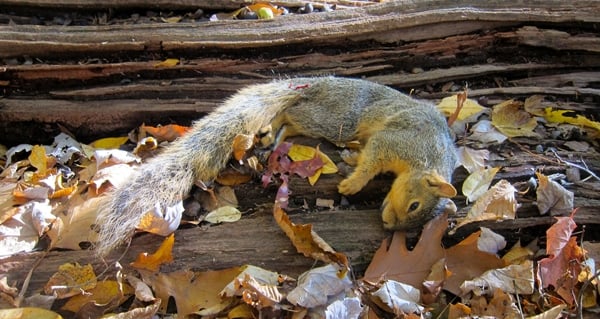
Squirrel season is upon us here in California, so I reckon it’s time to offer up to you how I cut up a squirrel for eating.
As with any sort of butchery, different people do it different ways. Some people simmer them whole. The Hmong hunters I know actually scald their squirrels and scrape off the hair — or just toss them into the fire to burn off the hair. I need to try that scalding sometime to see if squirrel skin is any good.
Until then, I skin and cut up my limb chickens. If you’ve never done it, skinning a squirrel is a bit harder than you might think. Squirrels have a thick, dense hide, whereas rabbits, their woodland colleagues, have more of a light pelt. Skinning a rabbit takes seconds. Skinning a squirrel takes a few more seconds.
To skin, gut and break down a squirrel properly, you will want to have handy:
- Water
- A cutting board
- A small, sharp knife, such as a pocket knife or small paring knife
- kitchen shears
- A trash bin
- A platter or tray to put the finished squirrel pieces on
Start by snipping off Mr. Squirrel’s head, feet and tail with the shears. Use the bone-cutting notch at the base of the shears if you have one. I do the same thing with the head, but it a) requires some hand strength and b) deprives you of that Appalachian delicacy, squirrel brains. I am not a fan, so I toss those heads. If you happen to be a squirrel brain enthusiast, by all means skin and split the skull in your own way.
You are now left with a sad-looking, tailless, headless squirrel. Take your knife in one hand, and with the other pinch up the loose skin at the center of the squirrel’s back: Use the knife to make an incision perpendicular to the squirrel’s backbone about 2 inches long. (Incidentally, the process is similar for cutting up rabbits for cooking. )
To skin the squirrel, work two fingers of each hand under the skin through the incision you just made. Now pull – I mean really pull! — and the skin will come off in either direction. You’ll get it most of the way, but the skin will hang up under the legs and at the center of the belly.
Poke your finger through under the legs to free the skin off them. Use the knife to carefully start the belly skin going, then pull it, too. It takes a little practice, but it’s not rocket science.
To gut Mr. Squirrel, use the knife with the blade facing away from the guts to open up the wee beastie. His guts will spill out. Reach with your fingers upwards toward the heart and lungs and wrench them out. Save the heart. If you want, save the liver and kidneys, too. They’re tasty. Use the kitchen shears to split the pelvis so you can get the remaining bits of poop chute out.
Wash the squirrel under lots of clean, cold water and you are ready to break him down.
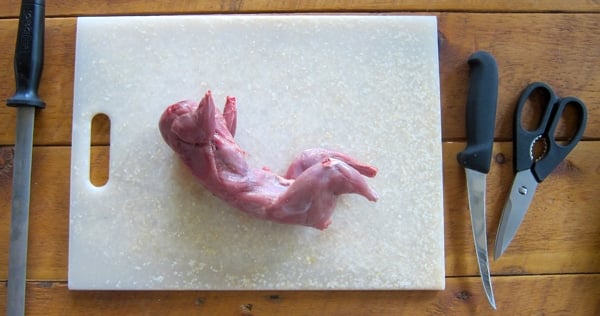
I start by removing the legs. The front legs of most mammals are completely free of the rest of the skeleton. Trippy, eh? But not you and me — we have a collar bone. So does Mr. Squirrel. He’s the only game animal I know of with one.
Even so, use your knife to slice down to the ribcage behind the front leg, then slice along the bones toward the squirrel’s neck until you free the foreleg; you will have to slice through a skinny little collar bone at the end. Do this on both forelegs.
The hind legs on pretty much everything, including us, are attached with a ball-and-socket joint. So too with Mr. Squirrel. Use your knife to slice the meat on the inside of the squirrel’s leg where it attaches to the body until you can see the ball joint. Bend the leg backwards until you pop that joint out. Slice around it to free the legs. Do this with both sides.
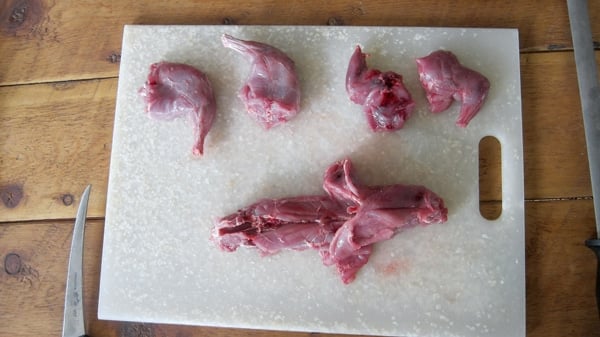
You’re almost done. You are left with the torso and belly flaps. I slice off the belly flaps and save them for either stock or for stir-fries. That leaves the ribs and backstraps.
Use kitchen shears to snip off the ribs. Save for stock. Now you want to portion out the backstrap. A big squirrel might give you two pieces, but most are just one. You can either use your shears for this, although it requires a bit of strength, or you can use a cleaver and whack it into pieces. One thing you definitely want to do is chop off the hips and the neck portions, as there is not much meat there; again, save these bits for stock.
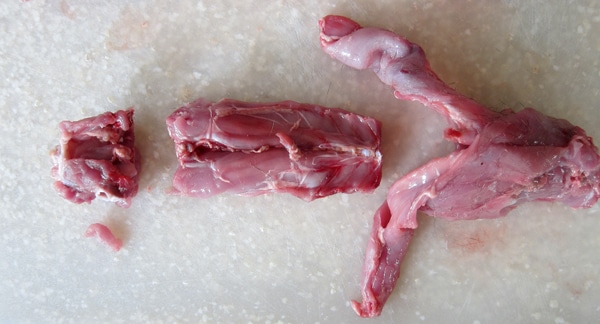
When you’re done, it should look like this:
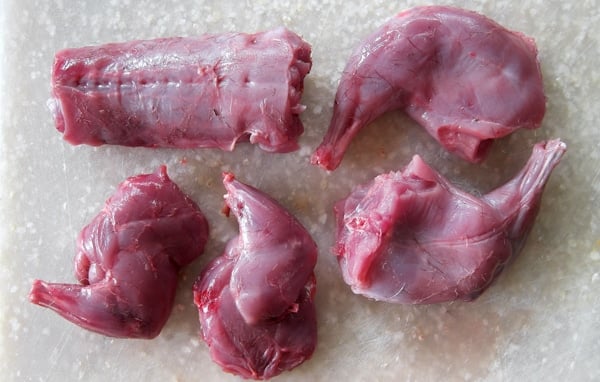
Don’t sweat it if you mess up the first couple times, or if it takes you a while. You’ll get the hang of it, and when you do, this process can be done in less than 10 minutes per squirrel.
Now that you have a squirrel ready for cooking, here are all sorts of squirrel recipes to choose from!
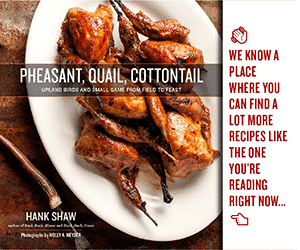




Thank you for the article and the recipes, I hope to try them soon (if I don’t gross my sister out!)
One thing I would like to put out here for those who enjoy squirrel brains–don’t eat them. A man who had an exceeding fondness for them contracted a form of Creutzfeldt-Jakob disease from one of the critters. Squirrels are not nice creatures, the males will kill and eat the babies whether they fathered them or not. Cannibalism is a source of some of these kinds of diseases. Just an fyi.
Jacque: That story is flawed. The Lancet first published it many years ago, and then retracted it. Bottom line is the evidence is unclear on the connection between squirrel brains and disease. Given that, I don’t eat them.
Seems like a lot of hair is left on the portions. Is that intentional or ignored?
So you don’t field dress them like a deer? Save all the work for when you get home? If that’s the case, do you ice them down for transport home?
Sean: Only when it’s warm out, but yes, I keep a cooler in the truck.
I remember my uncle hanging them for a week (I believe) in an old refrigerator. Is this necessary ?
Eric: That might be a bit long for a squirrel, but many people will hang squirrels and rabbits a few days.
It’s been a banner year for squirrels in Northern Vermont! I made the Brunswick Stew and Buttermilk Fried Rabbit recipes (using squirrel) from PQC. Very tender and sweet!
Where can I buy squirrel méat ? Must one hunt them? Is it possible to buy them fresh or Frozen?
Pierre: Yep, you need to hunt them. Only place I know of where you can buy squirrel is England.
What would you consider to be the easiest tried and true method of catching, terminating and processing a squirrel for human consumption?
Michael: Hunting.
+1 to Jesse’s comment. That is the quickest way to skin. Best of all, you don’t need a clean surface (like a table) to do it, so it makes for easy cleaning when cooking in the woods is in order.
And Hank – I love the writing you’ve done and are doing. It’s good to see someone appreciate both hunting and good food so well. Often, the two miss each other somehow.
The quickest and easiest way I have found to skin a squirrel is to fold its tail back and slice the skin between the base of the tail and the anus. Snip though the tail bone and continue to slice until you have about a 1.5 inch skin flap. Step on the flap and pull the hind legs. Make sure you are on the flap and not the tail. The tail will break. All the skin except what is on the hind legs will peel over the head kind of like a shirt. Slide your fingers under the skin on the hind legs and pull it over the back paws like socks. Snip off the head and feet and you are ready to gut it. This makes it almost as easy as rabbit.
Simpler and faster/easier to gut and skin a squirrel like a small deer. 54 years of hunting taught me that, about 42 years ago…
Looking for other thoughts on squirrel liver. Any other recc’s. Thanks, Sid
Thanks very much for the instructions on skinning the squirrel. Have hunted for 50 years or so but shot (my brother actually) our first bushytails last week. Arizona has five sub species. These were Abert’s. Made your recipe for Greek Mulligan Stew with Swiss Chard. Delicious. Thanks again. tom
Yes, Jerry.
There’s a glands in each leg on the back side where the two muscle groups come together. You’ll see a small, white, triangular area. I make a small slice upwards on each side of the patch and then dig it out with my fingers. It’s a little ball like gland with a dull light brownish or grayish color.
The same goes in the front arm in the area opposite the elbows. You’ll see the white patch to n each. Again, slice those open and remove the little gland from each.
Also, under each arm in the armpit area you’ll see what looks like a fatty deposit. Remove that brownish looking fat from each side.
I always do this, but I can also tell you I’ve eaten squirrel without them removed and the meat didn’t taste bad. I figure it can’t hurt.
The one thing that will definitely affect the taste of the meat though is the bile sack. When you are cleaning the squirrel it is imperative that you don’t cut the bile sack down by the pelvis area.
Try not to hit the bladder or intestines either, but waste will wash out when you rinse if you accidentally do. But, there is something about the bile that definitely sticks to the meat flavor.
Do squirrels have scent glands? I was boiling one to put in pot pie, but it had a strong smell.
When I skin a squirrel I chop off tail head and feet. Make a small incision down the back bone place your fingers in and rip.. Comes apart pretty easily until you hit the shoulders \ elbows.
I’ve been hunting squirrels in California for many years. Skinning techniques vary, but it’s the cooking that is important. Being a tougher meat than rabbit, I slow roast the squirrel at 275 degrees for two hours, covered. Then debone it and make enchiladas, casseroles, stew. Tasty little buggers. Someone should teach the homeless to use slingshots in the city and supplement their diets.
I prefer the method i was taught by my father who grew up in Michigan:
1. Make small incision under tail.
2. Hold back feet together and use tail as handle and pull towards head.
3. Pull until front legs begin to peel. Do not pull off of front legs.
4. Use hole from legs and skin to hook over small branch (if still in the woods) or hook if at home. Skin is left on belly and comes to a point.
5. Grab point of skin and peel to back feet.
6. Cut feet off front and back legs and remover head.
It may sound like alot, but i can skin a squirrel in less than 30 seconds this way.
Adam: Thanks for the skinning tips. I do that, too. This post is on cutting up a squirrel for cooking after it has been skinned, however.
A must do just after skinning. Remove the musk glands under the front arm pits by making a cut under the front sholders . Takes the wildness out of the meat….
Eugene: I have skinned hundreds of squirrels and have never done that, and have always enjoyed eating my squirrels.
Botfly larvae, while unpleasant in theory, are harmless and the meat of squirrels infested with “warbles” is perfectly safe. The Georgia Fish and Game Commission, for one example, is actively trying to educate hunters so they will stop unnecessary waste of squirrels because the hunter believes or has been misinformed that “warbles” are dangerous or ruin the meat.
If a squirrel has lesions *throughout* its musculature, it should always be discarded, but this is not related to botflies. It may indicate a serious infestation of worms or other disease.
From GA Wildlife Dept. Website (https://georgiawildlife.com/node/525)
“During September and October, squirrels often are infested with botfly larvae, sometimes called warbles or “wolves.” These larvae develop under the squirrel’s skin, similar to the warbles described in the chapter on rabbits. Although these warbles are not fatal to the squirrel or harmful to the hunter, the ugly lesions prompt many hunters to discard infested squirrels. The discarding of warble infested squirrels is unfortunate. Even though these lesions are unsightly, the squirrel’s meat is quite edible. By late October, most warbles have left their host.”
I have never heard of someone cleaning a squirrel this way. Talk about making something way too hard. Cut just under the base of the tail until the tail bone is cut through. Lay the squirrel on his back, step on the base of the tail and pull up by the rear legs. I can skin AND gut a squirrel in under a minute. Add another minute to quarter. There is NO reason for it to take 10 minutes to do this.